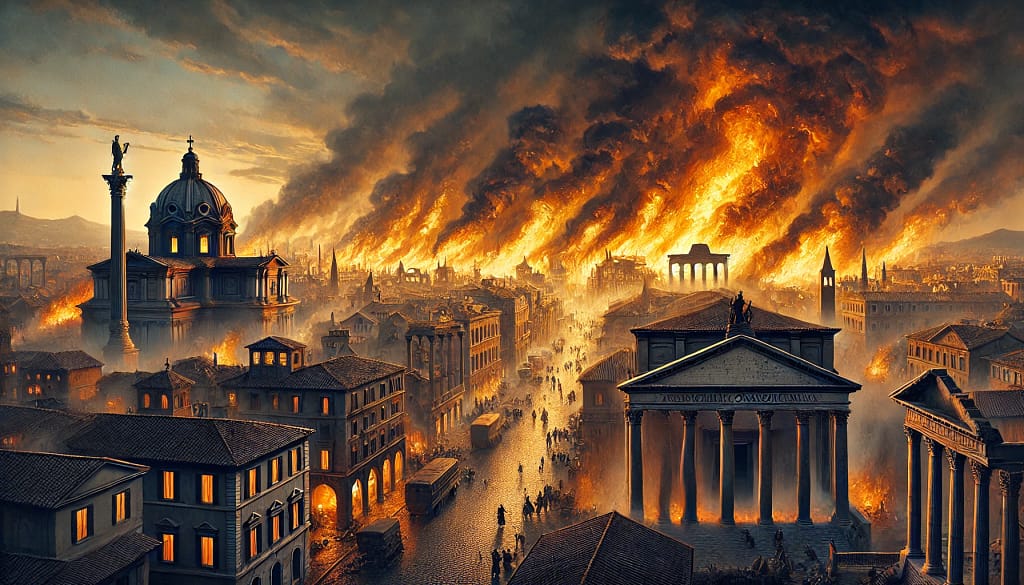
Let’s imagine we are witnesses to the events that led to the martyrdom of the first Christians in Rome. The narrative will blend historical facts with imaginative elements to bring the story to life.
A Witness to the First Martyrs of Rome
The year was AD 64, and Rome, the heart of the vast Roman Empire, was a city bustling with life and activity. Traders from far-flung corners of the world filled the markets, soldiers marched through the streets, and the grand architecture of temples and public buildings spoke of the city’s might and splendor. But beneath the surface, tensions simmered.
I remember the night it all began as if it were yesterday. It was the 19th of July, and an unusual stillness settled over the city, an eerie calm before the storm. Suddenly, a flicker of light appeared on the horizon, quickly transforming into a blazing inferno. The Great Fire of Rome had begun.
For six days, the fire raged, consuming everything in its path. Homes, shops, and temples were reduced to ash. The smell of burning wood and flesh filled the air, and the cries of the terrified citizens echoed through the streets. Amid the chaos, Emperor Nero watched from his palace. Rumors began to spread like wildfire, much like the flames engulfing the city. Whispers of Nero’s involvement in the fire reached every corner, with some saying he had played his lyre while Rome burned.
Desperate to divert the growing anger and suspicion from himself, Nero needed a scapegoat. The Christians, a small but growing sect within the empire, were an easy target. Their refusal to worship the Roman gods and their clandestine meetings made them objects of mistrust and misunderstanding. Nero seized the opportunity, accusing them of starting the fire.
The first arrests were swift and brutal. Men, women, and even children were rounded up, dragged from their homes in the dead of night, and thrown into prison. The air was thick with fear and uncertainty. Among those arrested was a man named Peter, a prominent leader of the Christian community, known for his unwavering faith and wisdom.
Peter and the others were brought before Nero in a mockery of a trial. The emperor, with a cruel smile, pronounced their sentence: they would be executed publicly as a spectacle, a warning to others. The methods of execution were chosen for their brutality and their ability to inflict maximum suffering. Some were sewn into the skins of wild beasts and left to be torn apart by dogs in the Circus Maximus. Others were crucified along the roads leading into the city, left to die slowly and painfully under the scorching sun.
But the most horrifying of all was the fate of those chosen to serve as human torches. They were dipped in tar, tied to stakes, and set alight to illuminate Nero’s gardens at night. I remember standing among the crowds, watching in horror as the flames consumed them. Yet, amid their agony, many of them sang hymns and prayed, their voices rising above the crackling of the flames. Their courage and faith left an indelible mark on my soul.
Peter himself was crucified, but he requested to be hung upside down, feeling unworthy to die in the same manner as his Lord, Jesus Christ. His death was a profound testament to his humility and unwavering devotion.
The martyrdom of these early Christians did not have the intended effect of quelling dissent. Instead, it ignited a fire of a different kind, a fire of faith and resilience that spread far beyond the walls of Rome. The courage and conviction of these first martyrs inspired others to join the Christian faith, even as it remained perilous to do so.
As the years passed, their stories were told and retold, written down by those who sought to preserve their memory. The writings of early historians like Tacitus and Suetonius, though biased and incomplete, give us glimpses into those dark days. The Christian community, despite persecution, grew stronger, bound together by the blood of the martyrs and the hope of eternal life.
Today, standing in the shadow of the Colosseum and the ruins of ancient Rome, I remember those brave souls. Their sacrifice was not in vain. They bore witness to a faith that would endure through the ages, a faith that continues to inspire and transform lives.
The legacy of the first martyrs of Rome is a testament to the power of faith and the resilience of the human spirit. Their story reminds us that, even in the face of unimaginable suffering, hope and love can prevail. And as long as their memory is honored, the light they kindled will never be extinguished.
This narrative blends historical facts with imaginative elements to bring to life the story of the first martyrs of Rome, providing a poignant and powerful reminder of their enduring legacy.